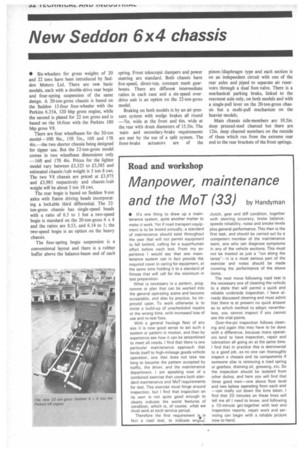Road and workshop
Page 34

If you've noticed an error in this article please click here to report it so we can fix it.
Manpower, maintenance
and the MoT (33) by Handyman
• It's one thing to draw up a maintenance system, quite another matter to make it work. Yet if road transport equipment is to be tested annually, a standard of maintenance should exist throughout the year that will not permit equipment to fall behind, calling for a superhuman effort before each test. From my experience I would say that one maintenance system can in fact provide the required cover in caring for equipment, at the same time holding it to a standard of fitness that will call for the minimum in test preparation.
What is necessary is a pattern, programme or plan that can be worked into the general operating scene and become acceptable, and also by practice, be improved upon. To work otherwise is to invite a build-up of unscheduled repairs at the wrong time, with increased loss of use and re-test fees.
With a general haulage fleet of any size it is now good sense to set such a system or pattern in motion, and then by experience see how it can be streamlined to meet all needs. I find that there is one particular maintenance approach that lends itself to high-mileage goods vehicle operation, one that does not take too long to become the pattern accepted by traffic, the driver, and the maintenance department. I am speaking now of a combined exercise that covers both standard maintenance and MoT requirements for test. This exercise must hinge around inspection, but I find that inspection on its own is not quite good enough to clearly indicate the worst features of condition, which is, of course, what we must seek at each service period.
Therefore the first requirement is*. in fact a road test, to indicate enginf, clutch, gear and diff condition, together with steering accuracy, brake balance, speedo reliability, noise and smoke levels plus general performance. This then is the first task, and should be carried out by a competent member of the maintenance team, one who can diagnose symptoms in any of the vehicle sections. This must not be treated as just a "run along the lanes"—it is a most serious part of the exercise and notes should be made covering the performance of the above items.
The next move following road test is the necessary one of cleaning the vehicle to a state that will permit a quick and reliable underside inspection. I have already discussed cleaning and must admit that there is at present no quick answer as to which method to adopt; nevertheless, you cannot inspect if you cannot see the vital points.
Over-the-pit inspection follows cleaning and again this may have to be done with a difference, because many operators tend to have inspection, repair and lubrication all going on at the same time. I find that in practice this is detrimental to a good job, as no one can thoroughly inspect a chassis and its components if someone else is removing a road spring or gearbox, draining oil, greasing, etc. So the inspection should be isolated from other duties, and here you will find that three good men—one above floor level and two below operating from each end —can really cut down the time taken. I find that 20 minutes on these lines will tell me all I need to know, and following a 10-minute get-together with test and inspection reports, repair work and servicing can begin with a reliable picture now to hand.








































































































